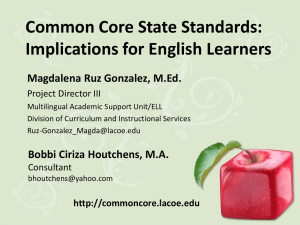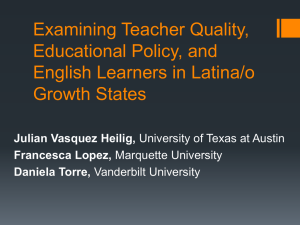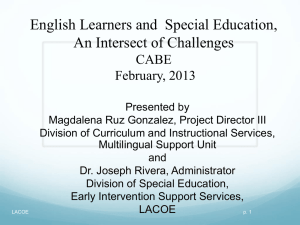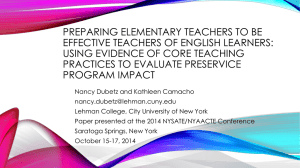introduction
advertisement
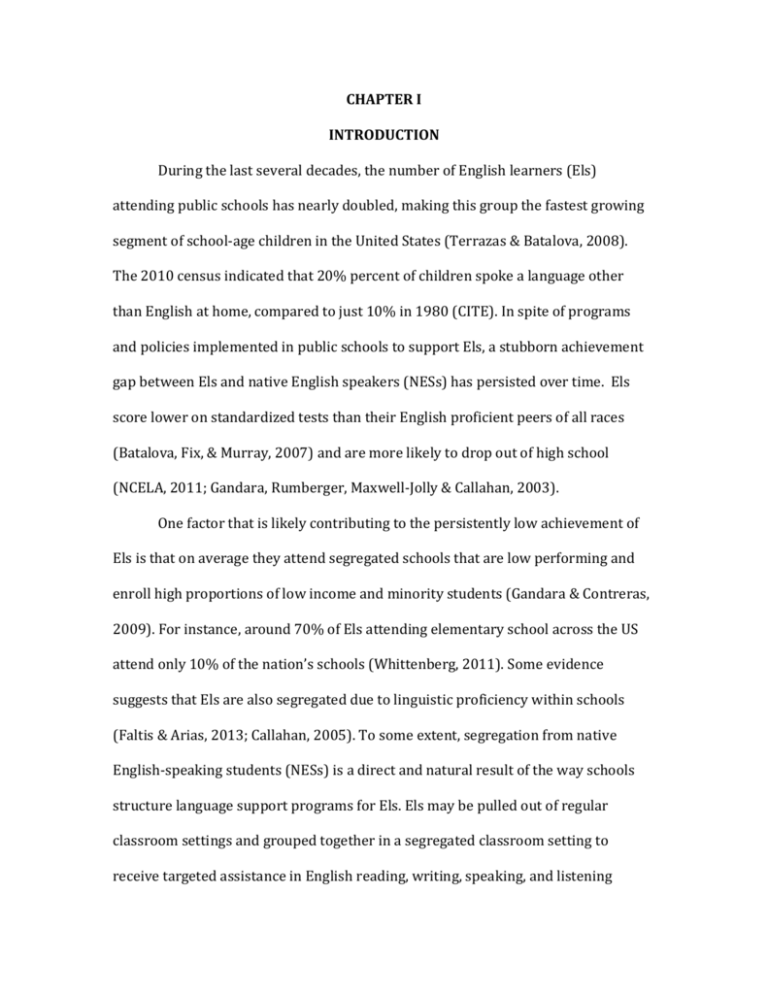
CHAPTER I INTRODUCTION During the last several decades, the number of English learners (Els) attending public schools has nearly doubled, making this group the fastest growing segment of school-age children in the United States (Terrazas & Batalova, 2008). The 2010 census indicated that 20% percent of children spoke a language other than English at home, compared to just 10% in 1980 (CITE). In spite of programs and policies implemented in public schools to support Els, a stubborn achievement gap between Els and native English speakers (NESs) has persisted over time. Els score lower on standardized tests than their English proficient peers of all races (Batalova, Fix, & Murray, 2007) and are more likely to drop out of high school (NCELA, 2011; Gandara, Rumberger, Maxwell-Jolly & Callahan, 2003). One factor that is likely contributing to the persistently low achievement of Els is that on average they attend segregated schools that are low performing and enroll high proportions of low income and minority students (Gandara & Contreras, 2009). For instance, around 70% of Els attending elementary school across the US attend only 10% of the nation’s schools (Whittenberg, 2011). Some evidence suggests that Els are also segregated due to linguistic proficiency within schools (Faltis & Arias, 2013; Callahan, 2005). To some extent, segregation from native English-speaking students (NESs) is a direct and natural result of the way schools structure language support programs for Els. Els may be pulled out of regular classroom settings and grouped together in a segregated classroom setting to receive targeted assistance in English reading, writing, speaking, and listening (Aguilar, Canche, & Sabetghadam, 2012). In other cases, Els are segregated from NESs when schools practice academic tracking (Kanno & Cangas, 2014; Callahan, 2004). Because Els are typically low achieving students, schools may track them in to low-level math or Language arts classes, where they have limited exposure to NESs or English proficient second language speakers. There is little understanding of how Els are systematically segregated from or included with the mainstream student population. Moreover, research documenting whether segregated or inclusive classroom environments are better suited for supporting the language development of Els and increasing their academic achievement is inconclusive (Aguilar, et al, 2012). This research gap is problematic because the way schools are structured to support Els is largely based on assumptions about how Els learn and their potential for academic achievement instead research-based practices (Reeves, 2004). Els may also be systematically underachieving because their teachers are not prepared to adequately support their linguistic and academic development (Harklau, 2004; OTHERS). A pervasive theme across studies of teachers working with Els is that there tends to be a shortage of ESL certified or trained teachers (CITE) and that many teachers who teach these students feel ill equipped for the task (CITE). However, few studies have investigated the impact of specific teacher characteristics on El achievement. Despite an abundance of research debating the relative merits of teacher credentialing, experience, training, and other characteristics for increasing student achievement (CITE), studies specifically focused on how these same characteristics impact Els are scarce (CITE). Thus, research related to who teaches Els has uncovered systematic problems but has discovered few policy levers, such as changing credentialing or preparation requirements, that can be manipulated to solve them. Finally, Els may be under-achieving at school not only because of school characteristics, but because of their family and personal histories. Els are a distinct group of students not only because they are learning English in schools, but also because they are typically immigrants or the children of immigrants. Immigrants, especially those who are minorities and who have low socioeconomic status, tend to be a marginalized population. There is a rich theoretical and empirical literature explaining the educational experiences of immigrant students. However, in the last few decades, immigration patterns have changed dramatically, bringing immigrant adults and children to states, districts, and schools that previously had little experience providing services to this population. A new thread in immigrant research has emerged focusing on the experiences of immigrants in these “new destinations”; however, the classroom and school experiences of immigrants in these locales have not been investigated across an entire state. In my dissertation, I seek to fill some of the knowledge gaps described above and illuminate some of the contextual variables that influence the academic outcomes of Els in a new immigrant destination. By contextual variables, I mean the extent to which Els are segregated from other students in their classrooms and schools and whether their teacher has an ESL credential. To that end, I ask the following questions: 1. To what extent are the math and ESL classroom contexts of current Els, former Els, and NESs, similar or different? i. To what extent do the classroom contexts of current Els, former Els, and NESs vary over time and in schools with different proportions of Els? 2. How does classroom context impact the academic achievement of Els in reading and math? i. To what extent is the relationship between the classroom context and El achievement moderated by the school context? To answer my questions I use descriptive analyses and multiple regression. In order to control for non-random sorting of students into schools and classrooms, I employ student and school fixed effects. Theoretical Frame To understand the academic experiences of Els I turn to theoretical frameworks that explain immigrant assimilation and the importance of teachers for at-risk student populations. First, borrowing from the theory of segmented assimilation (Portes & Zhou, 1993), I conceptualize the classroom and school as an important context of reception that impacts a student’s ability to assimilate. Within the school context, positive assimilation is indicated by high academic achievement and proficiency in English. I define the context of reception within the school setting as the structures that support Els’ second language acquisition, how receptive the school community is to El students, and the size of El population within the school. Importantly, the school context of reception can influence the extent to which Els are segregated from or included with English proficient students in their classes and their access to credentialed ESL teachers. For the purposes of this dissertation, I concentrate on two of the five dimensions of segregation defined in the literature: evenness and exposure (Massey & Denton, 1988). Eveness describes the distribution of Els within a unit (eg classrooms, schools, or districts) and exposure describes the extent to which Els interact with non-Els within a unit. Next, following Stanton-Salazar’s theory of institutional agents, I conceptualize teachers as having a key role in helping Els access institutional resources, such as knowledge of how American schools work and academic opportunities. Additionally, teachers, as institutional agents, are in the position to advocate for Els within the school community, serve as role models, and provide guidance. I posit that teachers who have indicated a commitment to working with Els by obtaining an ESL credential are most likely to fill the role of a positive institutional agent. Significance My research lays important groundwork for understanding how segregation, teacher characteristics, and immigration patterns impact the academic lives of Els. Many of the research gaps described above are a result of data constraints. In order to analyze both within school segregation and teacher effectiveness on a large scale, researchers need access to student level data that can be liked to teacher level data or class rosters. My dissertation uses information from a comprehensive and longitudinal dataset from North Carolina that allows me to match students to teachers and build class rosters to overcome many data-related obstacles that have stymied other researchers. As such, I am able to make three distinct contributions to the literature related to school improvement for students at risk of academic failure. First, my study offers a unique contribution to the abundant literature on school segregation by describing the segregation of Els from non-Els in their schools and quantifying any impact segregation may have on achievement. Next, as the first study to investigate the level of access Els have to credentialed or trained teachers across an entire state as well as how access impacts achievement, my dissertation adds both to the literature on equitable access to resources for at-risk students as well as the literature on teacher effectiveness. Finally, my data comes from North Carolina, a “new destination” state that has experienced one of the fastest growing immigrant populations across the country. Thus, my study will extend what scholars know about the educational experiences of Els to “new destinations”. Overview Els are a marginalized and at-risk student population, who make up an increasingly large proportion of public school students. These students are no longer solely concentrated in large urban centers in border states and immigrant gateways, but are enrolled in rural, suburban, and urban schools across the country. This demographic reality, coupled with the persistent achievement gap between Els and native English speaking students, demands that states, districts, and schools reexamine how they structure schools and train teachers to adequately support Els. The purpose of this dissertation is to build a foundational knowledge around what classroom contexts are productive for English learners. Specifically, I aim to investigate the impact of segregation of Els from NESs and teacher credentialing on El achievement. In chapter two I present a review of relevant literature in three domains: school segregation and its repercussions, teacher preparation and effectiveness, and immigration patterns. In chapter three I present a theoretical framework based on the review of the literature that grounds my subsequent research methods. I detail my research design, describe the data and the construction of the analytical sample, and then lay out my analytic plan. Finally, I discuss the limitations of my study and my strategy for addressing them. In chapter four, I present the results of my descriptive and regression analyses and offer my interpretation of the findings. Lastly, in chapter five I discuss the implications my findings have for policy at the school, district, and state level.
